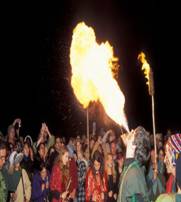The other four are points in the solar calendar. These are Spring and Autumn Equinox (when the length of the day is exactly equal to the night), Summer and Winter Solstice (longest and shortest days of the year). Neolithic sites such as Stonehenge act as gigantic solar calendars which marked the solstices and equinoxes and show that solar festivals have been significant dates for hundreds of thousands of years.
Yule
The Yule festival of Pagans is celebrated as Winter Solstice on December 21 or 22.This was a festival which was initially celebrated by the people of Northern Europe. In the course of Christianization the festival of Yule was pushed to December 25th and hence it is always compared with Christmas. But however today the Pagans celebrate it on December 21st or 22nd.The Pagans believe that it is during the time of Yule the Goddess gives birth to the Sun God which is repeated every year. Though this the Pagans symbolize that life is a process of death and rebirth as a continuous cycle that is reflected in the changing seasons. In olden days Yule was just celebrated by bonfires and feast, whereas today they celebrate elaborately by having family dinner, setting up of bonfires of Yule log, hanging holly and mistletoe and they also exchange gifts among friends and family members. The events also include worshipping ceremonies like prayer and singing of songs.
Autumn equinox
The festival of Autumn Equinox which is also known as Mabon or Harvest Home is the last festival of the harvest season. This is usually celebrated when the length of the day and night are equal. The Pagans end the season as thanking the harvest Goddess for the season which is past and also they have to realize the balance of the year has changed and astrologically this is the day where the sun enters the sign of Libra.
Imbolc
Imbolc marked by a cornerstone in the Celtic calendar, is a festival which symbolizes making way for the new and thanking for what ever good happened in the past, thus it is the preparation for renewal and growth. Imbolc indicates the welcoming of spring after winter and also mother Goddess after giving birth to the Sun Goddess. According to the calendar of Christians Imbolc is celebrated as 'Candlemas' when candles are lit to remember the purification of the Virgin Mary. It is a custom of the Pagans to gaze at the renewed energy imparted by the flames of these lit candles for strength and positive feeling and thanking God for the past, present and future. This is followed by lighting of all the lamps of the house after sunset for a long while. The festival is adorned by placing various colours of candles like Red, orange, pink, white, brown and light green candles in silver holders and various kinds of crystals on a yellow altar cloth. A small silver dish holds herbs of the Sabbat: bay leaves, angelica, basil, myrrh, tansy and coltsfoot.
Spring equinox
This festival of spring equinox is celebrated with lot of rituals and it is still followed with slight changes. According to astrology this occurs when the earth's axis is tilting neither towards nor away from the sun and it is directly above the equator. Spring Equinox is celebrated in the name of Ostara or Oestra. Ostara which symbolizes a new life and fertility. It is from this name the word Easter is derived. Oestra is mainly signified by eggs and hares but however the later is now replaced by rabbits. But however most of the traditions involved for this festival remain the same.
The festival is also associated with lighting of incense at home on the eve of Spring Equinox related to cinnamon, nutmeg or frankincense. No festival is complete without a feast of food. This festival also involve the custom of egg painting where the eggs are boiled or emptied and decorated and it is then carried by children in the streets.
Beltane
Beltane is the celebration of the Celtic deity Bel and is celebrated before the wheel of the year turns back to Midsummer. This is a festival of fires of Bel. It welcomes the summer and prays for the fertility of the future. The Pagans main compound of the festival is fire for according to them fire cleanse, purify and increase fertility. During this festival young men and women go to the woods and collect blossoms and set a bonfire in the evening believing that it would lead to matches and marriages in the following year. People dance around a phallic symbol, Maypole. According to the Pagans the fertility of the Pagans is ensured by letting the cattle's pass between two fires for the smoke from it is supposed to be powerful. On this day people would leave branches of different trees at others' doors symbolizing their characters.
Samhain
It is during Samhain the departed ones are remembered and honoured. According to Pagans the people are not considered as dead but instead they are the living spirits as guardians for us and is a period for them to prepare themselves for reincarnation. The night of Samhain is considered to be very powerful for it is on this day the Pagans pray for the spirits of the dead ones and hoping of rebirth.Samhain is the traditional time for the annual slaughter to ensure food throughout the winter months.


